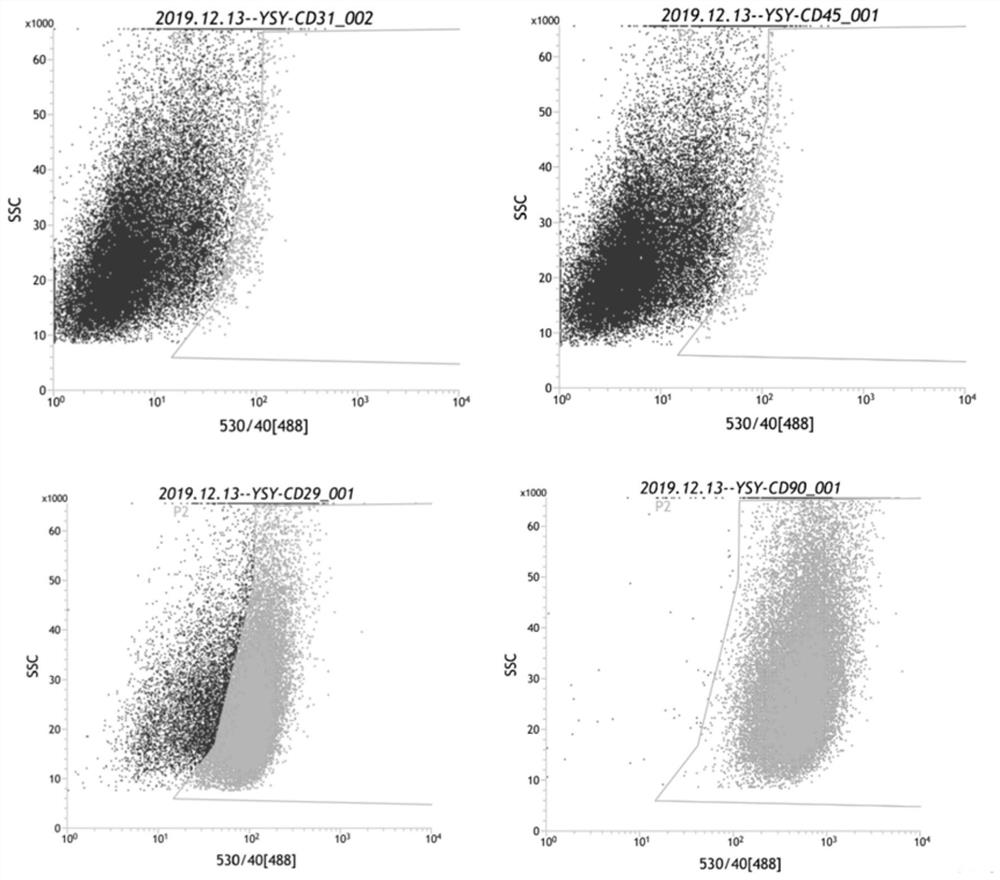Periodontal defect repair system containing Let-7a
A technology of let-7a and repair system, applied in genetically modified cells, cells modified by introducing foreign genetic material, bone/connective tissue cells, etc., can solve the problem of limited repair effect of periodontal defect repair system
- Summary
- Abstract
- Description
- Claims
- Application Information
AI Technical Summary
Problems solved by technology
Method used
Image
Examples
Embodiment 1
[0033] Example 1: Isolation and identification of periodontal ligament stem cells (PDLSCs)
[0034] The process of isolation, culture and passage of PDLSCs is as follows:
[0035]Premolars extracted due to orthodontic needs were collected, and the inclusion and exclusion criteria for sample collection were as follows:
[0036] Inclusion criteria: 12-18 years old; healthy without systemic diseases; healthy without caries; tooth root development completed.
[0037] Exclusion criteria: severe systemic diseases; dental caries or periapical lesions; root canal treatment; severe root resorption.
[0038] Soak the teeth in a PBS solution containing 2% bis-antibody, and store them in an ice box at low temperature. The storage time should not exceed 2 hours, and the next step is required. Transfer the isolated teeth to the ultra-clean bench, add new PBS solution containing 5% double-antibody to the isolated tooth, tighten the cap of the centrifuge tube, shake it up and down manually ...
Embodiment 2
[0043] Example 2: Preparation of PDLSCs cell aggregates and let-7a transfection
[0044] The P3 generation PDLSCs cells were routinely digested, neutralized, and counted in 3×10 5 seeded in six-well plates. The cells were cultured with complete medium, and the induction solution was added when the cells grew confluent to a cell density of 80%, and the induction solution was replaced every 3 days. Use the induction medium to induce the cultured cells for 7 days (37°C conventional culture in the incubator) to obtain PDLSCs cell aggregates. For the obtained PDLSCs cell aggregates, see Figure 4 .
[0045] The mature sequence of mmu-let-7a (MIMAT0000521) was obtained through the mirbase database. Let-7a mimics, inhibitor, and negative control were designed by RiboBio based on the mature sequence of let-7a. The sequence is as follows:
[0046] mmu-let-7a mature sequence: 5'-UGAGGUAGUAGGUUGUAUAGUU-3' (SEQ ID NO.1)
[0047] let-7a mimic sense strand: 5'-UGAGGUAGUAGGUUGUAUAGUU-3' ...
Embodiment 3
[0052] Example 3: In vivo repair of jaw defects with PDLSCs cell aggregates
[0053] The specific process for the preparation of PDLSCs cell aggregates transfected with let-7a mimic is as follows:
[0054] The media used include the following:
[0055] Complete medium (first medium): use α-MEM to prepare a medium containing 10% FBS and 1% double antibody (penicillin double antibody); induction solution (second medium): 50 μg / mL Complete medium of vitamin C; medium without antibiotics (the third medium): a medium containing 10% FBS was prepared with α-MEM.
[0056] Aggregate induction (to obtain the first cell aggregate): P3 generation PDLSCs cells were routinely digested, neutralized, and counted, and 3×10 5 seeded in six-well plates. Use the complete medium (the first medium) to culture the cells, and when the cells grow confluent to a cell density of 80%, add the second medium (replace the first medium with the second medium), and replace the second culture every 3 days ...
PUM
 Login to View More
Login to View More Abstract
Description
Claims
Application Information
 Login to View More
Login to View More - R&D
- Intellectual Property
- Life Sciences
- Materials
- Tech Scout
- Unparalleled Data Quality
- Higher Quality Content
- 60% Fewer Hallucinations
Browse by: Latest US Patents, China's latest patents, Technical Efficacy Thesaurus, Application Domain, Technology Topic, Popular Technical Reports.
© 2025 PatSnap. All rights reserved.Legal|Privacy policy|Modern Slavery Act Transparency Statement|Sitemap|About US| Contact US: help@patsnap.com



